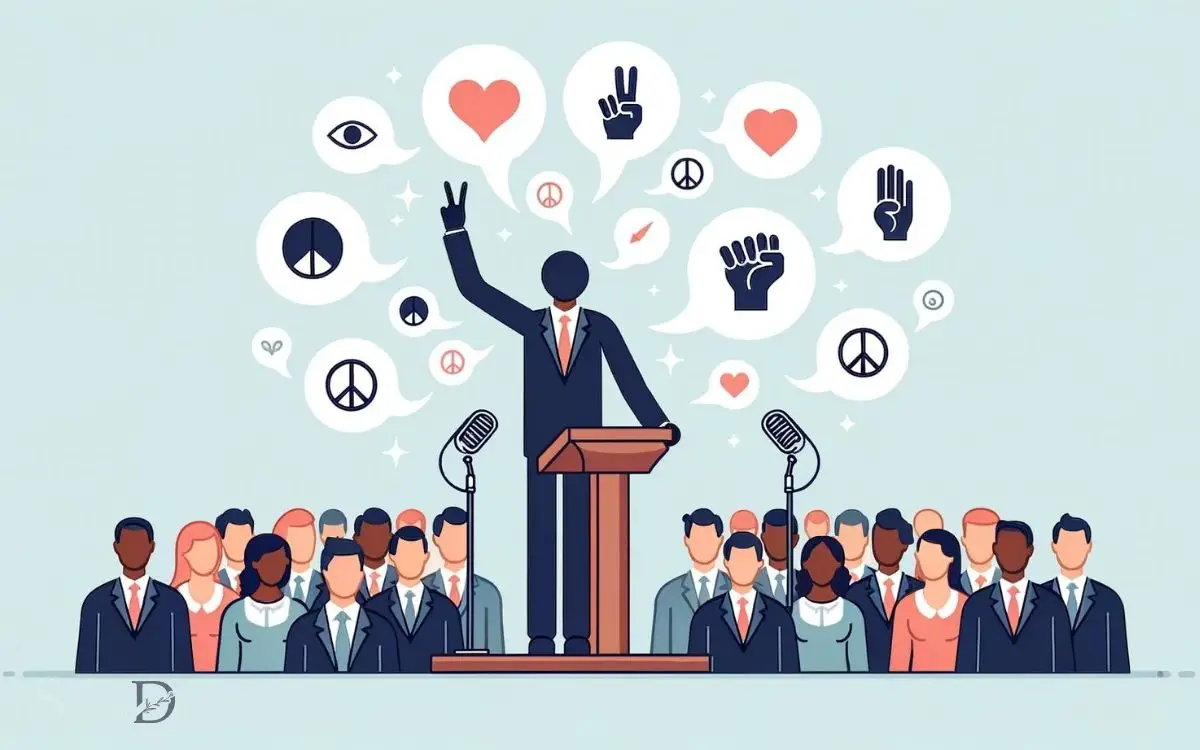What Does Symbolic Speech Mean? Actions!
Symbolic speech refers to nonverbal communication that expresses opinions or messages through actions, symbols, or behaviors rather than through spoken or written words.
It is recognized by courts, particularly in the United States, as a form of speech protected under the First Amendment to the U.S. Constitution.
Symbolic speech can take many forms, each serving as a powerful conduit for the transmission of ideas and sentiments.
Here are some examples and key points about symbolic speech:
- Wearing armbands or specific colors to show solidarity with a cause.
- Burning flags as a protest against government policies.
- Conducting sit-ins or peaceful protests to draw attention to an issue.
- Displaying symbols like the peace sign to communicate a desire for an end to conflict.
The legal protections afforded to symbolic speech mean that such expressions are often central to social and political activism.
However, there can be limitations; for instance, symbolic speech that poses a ‘clear and present danger’ or incites violence may not be protected.
Symbolic speech serves as the silent yet resounding voice of democracy, echoing personal freedoms through visual and physical representations.

Key Takeaway
The Concept of Symbolic Speech
The concept of symbolic speech encompasses the expression of ideas and beliefs through non-verbal forms of communication. This form of communication includes actions, symbols, signs, and other non-verbal expressions that convey a particular message or viewpoint.
Symbolic speech is often used when words may be insufficient to fully express the depth of certain convictions or emotions. It is a powerful tool for activism, protest, and artistic expression, as it can resonate deeply with individuals and communities.
Whether it is through art, gestures, clothing, or other expressive means, symbolic speech plays a significant role in shaping public discourse and raising awareness about important social and political issues.
Understanding the nuances and impact of symbolic speech is crucial in appreciating the diverse ways in which individuals exercise their right to freedom of expression.
Historical Roots of Symbolic Speech
Emerging in various historical contexts, the practice of symbolic speech has been deeply intertwined with the evolution of societal and political movements.
From ancient civilizations to modern-day activism, symbolic speech has played a crucial role in shaping the course of history.
Some key historical roots of symbolic speech include:
- The use of symbols by oppressed communities to resist tyranny and assert their identity.
- Symbolic acts of protest, such as Gandhi’s salt march, that have inspired mass mobilizations and political change.
- The visual and performative expressions of art and music as forms of resistance and solidarity in times of social upheaval.
These historical examples serve as powerful reminders of the enduring impact and significance of symbolic speech in advocating for social justice and political reform.
Legal Framework for Symbolic Speech
The legal framework for symbolic speech encompasses the protections and limitations set forth by the First Amendment.
Understanding the boundaries of expression and the extent of constitutional safeguards is crucial in grasping the complex landscape of symbolic speech. This form of communication often transcends spoken or written words, using actions or objects to convey deeper meaning. Symbolic possession and social status can also play significant roles in this realm, as individuals and groups use symbols to assert identity, values, or hierarchy within a society. Analyzing these dynamics helps clarify the interplay between personal freedoms and societal norms in defining the limits of symbolic expression.
Exploring the nuances of First Amendment protection and the constraints on expressive conduct provides insight into the legal foundation for symbolic speech.
First Amendment Protection
Legal protection for symbolic speech is grounded in the First Amendment of the United States Constitution. This fundamental right ensures that individuals can express themselves through nonverbal, often unconventional means.
The First Amendment protection for symbolic speech encompasses various forms of expression, including:
- Flag Burning: This controversial act is considered a form of protest and is protected as symbolic speech.
- Armbands: Wearing armbands as a protest against government policies is a recognized form of symbolic speech.
- Artistic Expressions: Creating art, sculptures, or other visual works to convey a message is protected under the First Amendment as symbolic speech.
Understanding the legal framework for symbolic speech is essential in safeguarding the rights of individuals to express themselves through diverse, nonverbal means.
Limits on Expression
Within the legal framework for symbolic speech, certain limitations are imposed on expression. The First Amendment provides protection for symbolic speech, but this protection is not absolute.
The government can restrict certain forms of expression if they present a clear and present danger or pose a direct threat to public safety.
For example, speech that incites violence, creates a hostile work environment, or constitutes a true threat is not protected under the First Amendment. Additionally, certain types of symbolic speech, such as flag burning or obscenity, may be subject to regulation or prohibition.
The legal framework balances the right to free expression with the need to maintain public order and safety. Understanding these limitations is crucial for individuals and organizations engaging in symbolic speech.
Examples of Symbolic Speech
Examples of symbolic speech include acts such as flag burning, wearing political badges, and using hand gestures to convey a message. These examples evoke strong emotions and can have a powerful impact on both individuals and society as a whole.
- Burning the flag can evoke feelings of anger, patriotism, or protest.
- Wearing political badges can express support, opposition, or solidarity with a cause.
- Hand gestures such as the raised fist can symbolize unity, strength, or resistance.
These forms of expression are deeply ingrained in societal discourse, often sparking intense debates and reactions. Understanding their significance and implications is crucial in comprehending the complexities of free speech and its role in shaping our communities.
Transitioning into the subsequent section, it’s important to explore the impact of symbolic speech in society.
Impact of Symbolic Speech in Society
The influence of symbolic speech on society is profound, shaping attitudes, beliefs, and actions through non-verbal communication.
Symbols convey powerful messages that can evoke strong emotional responses and trigger social change. They are instrumental in shaping cultural identities, fostering unity, and challenging societal norms.
For instance, symbols such as flags, gestures, and attire can represent political affiliations, religious beliefs, or social movements, influencing public opinion and mobilizing communities.
The impact of symbolic speech extends beyond verbal expression, as it resonates with individuals on a visceral level, transcending language barriers and stimulating collective consciousness.
However, the interpretation of symbols is subjective and can lead to differing perspectives and conflicts. Understanding the impact of symbolic speech is crucial in navigating the complexities of modern societies.
In examining the impact of symbolic speech, it becomes evident that there are various challenges surrounding its interpretation and application.
Challenges Surrounding Symbolic Speech
Navigating the complexities of modern societies poses significant challenges in interpreting and applying symbolic speech.
The following challenges contribute to the complexity of understanding and utilizing symbolic speech:
- Diverse cultural interpretations: Different cultures may interpret symbolic speech in contrasting ways, leading to misunderstandings and conflicts.
- Legal ambiguity: The legal framework surrounding symbolic speech is often ambiguous, making it difficult to determine the boundaries of freedom of expression.
- Rapid technological evolution: The rise of social media and digital communication has complicated the landscape of symbolic speech, creating new challenges for interpretation and regulation.
Understanding these challenges is essential for effectively navigating the realm of symbolic speech in modern society.
Moving forward, it is crucial to consider the potential impact of these challenges on the future of symbolic speech.
The Future of Symbolic Speech
As we look to the future of symbolic speech, it is crucial to consider the evolving landscape of digital expression and its impact on communication.
The rise of social media platforms has significantly altered the way individuals engage in symbolic speech, posing both opportunities and challenges.
Furthermore, understanding the legal implications and protections surrounding symbolic speech in the digital age will be essential for shaping its future trajectory.
Evolving Digital Expression
One significant aspect of the future of symbolic speech lies in the expanding array of digital platforms for expression.
As technology continues to advance, the ways in which individuals can express themselves digitally are constantly evolving. This evolution brings about new opportunities and challenges in the realm of symbolic speech.
- The immediacy of digital communication can evoke a sense of urgency and passion in expressing one’s beliefs.
- The global reach of digital platforms can foster a sense of unity and solidarity among like-minded individuals.
- The visual and interactive nature of digital expression can elicit strong emotional reactions, creating a profound impact on the audience.
These developments in digital expression not only shape the future of symbolic speech but also have the potential to significantly influence societal discourse and change.
Impact of Social Media
The proliferation of social media has profoundly shaped the future of symbolic speech, influencing the dynamics of public discourse and communication.
Social media platforms have become powerful tools for individuals and groups to express their beliefs, opinions, and ideologies in a symbolic manner.
The instantaneous and widespread nature of social media allows symbolic speech to reach a vast audience, transcending geographical boundaries and cultural barriers.
This has led to the democratization of symbolic speech, giving a voice to marginalized communities and enabling grassroots movements to gain momentum.
However, the impact of social media on symbolic speech is not without challenges, as the spread of misinformation and the potential for manipulation also pose significant concerns.
As social media continues to evolve, its role in shaping the future of symbolic speech will remain a topic of great interest and importance.
Legal Implications and Protections
The evolution of social media has prompted an examination of the legal implications and protections surrounding symbolic speech, particularly as it pertains to the future landscape of communication and public expression.
In this rapidly changing digital age, the following points highlight the emotional and societal impact of legal implications and protections for symbolic speech:
- Ensuring freedom of expression while preventing harm and discrimination
- Balancing individual rights with the collective well-being of society
- Navigating the complexities of regulating online platforms and virtual communities
As we navigate the future of symbolic speech, it is essential to strike a balance between upholding the fundamental right to free expression and safeguarding against the potential negative consequences that may arise in the digital realm.
Conclusion
The concept of symbolic speech encompasses a wide range of expressive acts and has a significant impact on society.
One interesting statistic is that a survey found that 61% of Americans believe that symbolic speech, such as flag burning, should be protected under the First Amendment.
This shows the ongoing debate and challenges surrounding the issue of symbolic speech in the United States.






